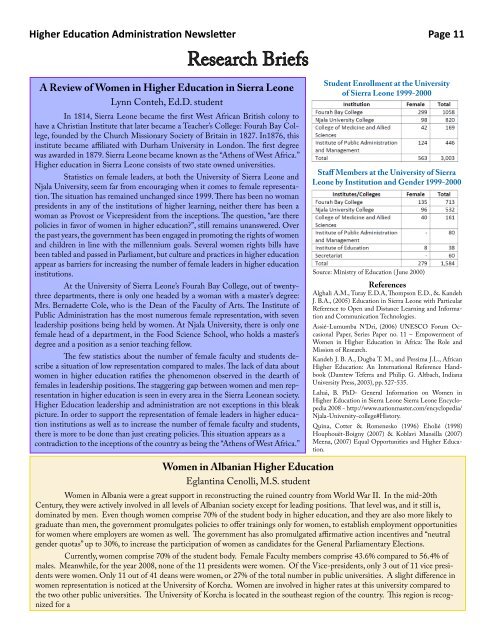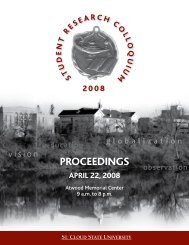Inside this issue: - St. Cloud State University
Inside this issue: - St. Cloud State University
Inside this issue: - St. Cloud State University
Create successful ePaper yourself
Turn your PDF publications into a flip-book with our unique Google optimized e-Paper software.
Higher Education Administration Newsletter Page 11<br />
Research Briefs<br />
A Review of Women in Higher Education in Sierra Leone<br />
Lynn Conteh, Ed.D. student<br />
In 1814, Sierra Leone became the first West African British colony to<br />
have a Christian Institute that later became a Teacher’s College: Fourah Bay College,<br />
founded by the Church Missionary Society of Britain in 1827. In1876, <strong>this</strong><br />
institute became affiliated with Durham <strong>University</strong> in London. The first degree<br />
was awarded in 1879. Sierra Leone became known as the “Athens of West Africa.”<br />
Higher education in Sierra Leone consists of two state owned universities.<br />
<strong>St</strong>atistics on female leaders, at both the <strong>University</strong> of Sierra Leone and<br />
Njala <strong>University</strong>, seem far from encouraging when it comes to female representation.<br />
The situation has remained unchanged since 1999. There has been no woman<br />
presidents in any of the institutions of higher learning, neither there has been a<br />
woman as Provost or Vicepresident from the inceptions. The question, “are there<br />
policies in favor of women in higher education?”, still remains unanswered. Over<br />
the past years, the government has been engaged in promoting the rights of women<br />
and children in line with the millennium goals. Several women rights bills have<br />
been tabled and passed in Parliament, but culture and practices in higher education<br />
appear as barriers for increasing the number of female leaders in higher education<br />
institutions.<br />
At the <strong>University</strong> of Sierra Leone’s Fourah Bay College, out of twentythree<br />
departments, there is only one headed by a woman with a master’s degree:<br />
Mrs. Bernadette Cole, who is the Dean of the Faculty of Arts. The Institute of<br />
Public Administration has the most numerous female representation, with seven<br />
leadership positions being held by women. At Njala <strong>University</strong>, there is only one<br />
female head of a department, in the Food Science School, who holds a master’s<br />
degree and a position as a senior teaching fellow.<br />
The few statistics about the number of female faculty and students describe<br />
a situation of low representation compared to males. The lack of data about<br />
women in higher education ratifies the phenomenon observed in the dearth of<br />
females in leadership positions. The staggering gap between women and men representation<br />
in higher education is seen in every area in the Sierra Leonean society.<br />
Higher Education leadership and administration are not exceptions in <strong>this</strong> bleak<br />
picture. In order to support the representation of female leaders in higher education<br />
institutions as well as to increase the number of female faculty and students,<br />
there is more to be done than just creating policies. This situation appears as a<br />
contradiction to the inceptions of the country as being the “Athens of West Africa.”<br />
<strong>St</strong>udent Enrollment at the <strong>University</strong><br />
of Sierra Leone 1999-2000<br />
<strong>St</strong>aff Members at the <strong>University</strong> of Sierra<br />
Leone by Institution and Gender 1999-2000<br />
Source: Ministry of Education ( June 2000)<br />
References<br />
Alghali A.M., Turay E.D.A, Thompson E.D., &. Kandeh<br />
J. B.A., (2005) Education in Sierra Leone with Particular<br />
Reference to Open and Distance Learning and Information<br />
and Communication Technologies.<br />
Assié-Lumumba N’Dri, (2006) UNESCO Forum Occasional<br />
Paper, Series Paper no. 11 – Empowerment of<br />
Women in Higher Education in Africa: The Role and<br />
Mission of Research.<br />
Kandeh J. B. A., Dugba T. M., and Pessima J.L., African<br />
Higher Education: An International Reference Handbook<br />
(Damtew Teferra and Philip. G. Altbach, Indiana<br />
<strong>University</strong> Press, 2003), pp. 527-535.<br />
Lahai, B. PhD- General Information on Women in<br />
Higher Education in Sierra Leone Sierra Leone Encyclopedia<br />
2008 - http://www.nationmaster.com/encyclopedia/<br />
Njala-<strong>University</strong>-college#History.<br />
Quina, Cotter & Romenesko (1996) Eholié (1998)<br />
Houphouët-Boigny (2007) & Koblavi Mansilla (2007)<br />
Meena, (2007) Equal Opportunities and Higher Education.<br />
Women in Albanian Higher Education<br />
Eglantina Cenolli, M.S. student<br />
Women in Albania were a great support in reconstructing the ruined country from World War II. In the mid-20th<br />
Century, they were actively involved in all levels of Albanian society except for leading positions. That level was, and it still is,<br />
dominated by men. Even though women comprise 70% of the student body in higher education, and they are also more likely to<br />
graduate than men, the government promulgates policies to offer trainings only for women, to establish employment opportunities<br />
for women where employers are women as well. The government has also promulgated affirmative action incentives and “neutral<br />
gender quotas” up to 30%, to increase the participation of women as candidates for the General Parliamentary Elections.<br />
Currently, women comprise 70% of the student body. Female Faculty members comprise 43.6% compared to 56.4% of<br />
males. Meanwhile, for the year 2008, none of the 11 presidents were women. Of the Vice-presidents, only 3 out of 11 vice presidents<br />
were women. Only 11 out of 41 deans were women, or 27% of the total number in public universities. A slight difference in<br />
women representation is noticed at the <strong>University</strong> of Korcha. Women are involved in higher rates at <strong>this</strong> university compared to<br />
the two other public universities. The <strong>University</strong> of Korcha is located in the southeast region of the country. This region is recognized<br />
for a
















